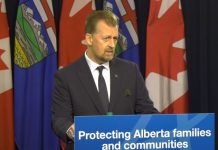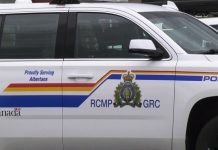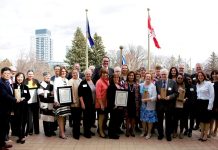Alberta’s big cities were the epicentre of COVID-19 for a period last fall but lately it’s rural areas that have seen the highest rates of active cases, relative to their population.
“I think there’s a misconception that there are no cases and no impact in rural zones,” Dr. Deena Hinshaw, Alberta’s chief medical officer of health, said last week.
“But, in actual fact, we have seen quite high numbers in some rural places.”
Alberta Health divides the province into 132 “local geographic areas” in order to monitor a variety of health outcomes and, as of Tuesday’s data update, the top 10 areas for active COVID-19 cases, per capita, were all rural.
Some of these areas have names similar to nearby municipalities but it’s important to note the boundaries defined by Alberta Health are not identical to the municipal boundaries you might be more familiar with.
Many of these rural areas don’t have massive outbreaks in terms of absolute numbers, but do have high numbers of active cases relative to the number of people who live there.
In the Frog Lake and Wabasca areas of northeastern Alberta, for instance, nearly 1 out of 100 people had an active case of COVID-19, as of Tuesday’s data update. A bit further north and west, in the La Lac Biche and High Prairie areas, it was about 1 out of 150 people.
Wetaskiwin County in central Alberta had the highest rate in the province in early January, with about 1 in 50 people battling an active infection at that time. But the numbers there have since been on the decline.
These recent trends stand in contrast to last fall, when the highest active-case rates were seen in Edmonton and Calgary.
But it’s not unusual for rural areas to see sudden spikes like this. An outbreak in a small community can quickly affect a significant portion of its population.
Since the pandemic began, there have been periodic surges in viral spread in a wide variety of locations, from the most remote corners of the province to the most densely populated urban areas.
“COVID-19 cannot be restricted to a specific municipality, and what we have seen … is how interconnected we all are,” Hinshaw said.
“The movement between different towns, the movement between large, urban centres and small rural areas — all of that movement is part of what spreads COVID-19.”
The interactive map below shows all 132 local health areas, as defined by Alberta Health, and the latest active-case rates in each area. The darker the shading, the higher the rate.
You can zoom in, scroll around and click on an area for more information.
You can also type the name of a community into the search bar to locate it on the map.
When you zoom in past a certain point, labels appear on each area showing the latest count of active cases.
































